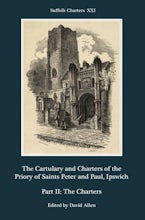
→
Recommend to library
Title Details
320 Pages
23.4 x 15.6 cm
10 b/w, 1 line illus.
Series: Suffolk Charters
Series Vol. Number:
18
Imprint: Boydell Press
The Charters of Stanton, Suffolk, c.1215-1678
- Description
- Contents
- Reviews
Edition of local documents sheds revealing light on medieval village life.
The village of Stanton, some nine miles north-east of Bury St Edmunds, is in many ways a typical Suffolk village. What is not so typical is the survival of a considerable and largely coherent collection of charters and similar texts, which together provide a rich and detailed picture of aspects of life in this village from the thirteenth to the seventeenth centuries. Most of the documents were written for, or involved, local peasants and farmers, and illustrate their own dealings with each other, with their lords (most importantly the nearby abbey of Bury), together with the involvement of prominent outsiders in the life of the village. The charters are therefore documents of greatinterest for the social and economic history of Suffolk, and of East Anglia more broadly, for the insights they provide into the lives of peasants and village people, into farming and other kinds of economic activity, into the operation of lordship and into the village's connection with the broader world. They present a microcosm of medieval and early modern Suffolk life, and typify kinds of activity that would have involved individuals across the countyand beyond.
This volume, a rich resource for historians, provides an edited collection, accompanied by introduction, notes and apparatus.
The village of Stanton, some nine miles north-east of Bury St Edmunds, is in many ways a typical Suffolk village. What is not so typical is the survival of a considerable and largely coherent collection of charters and similar texts, which together provide a rich and detailed picture of aspects of life in this village from the thirteenth to the seventeenth centuries. Most of the documents were written for, or involved, local peasants and farmers, and illustrate their own dealings with each other, with their lords (most importantly the nearby abbey of Bury), together with the involvement of prominent outsiders in the life of the village. The charters are therefore documents of greatinterest for the social and economic history of Suffolk, and of East Anglia more broadly, for the insights they provide into the lives of peasants and village people, into farming and other kinds of economic activity, into the operation of lordship and into the village's connection with the broader world. They present a microcosm of medieval and early modern Suffolk life, and typify kinds of activity that would have involved individuals across the countyand beyond.
This volume, a rich resource for historians, provides an edited collection, accompanied by introduction, notes and apparatus.
Introduction
List of Charters
Charters, 1-455
Appendix: Notes on People
Glossary
Bibliography
List of Charters
Charters, 1-455
Appendix: Notes on People
Glossary
Bibliography
"A work of superlative scholarship." MEDIAEVISTIK
"The Charters of Stanton stellt vor allem für die Regionalgeschichte eine Bereicherung dar." DEUTSCHES ARCHIV FUR ERFORSCHUNG DES MITTELALTERS
"Scholars will be grateful to Dymond for his yeoman's work in transcribing often difficult hands. [...] Social and legal historians will mine this for information." SCITECH BOOK NEWS
"The delight to medieval, late medieval and local historians is the very domestic nature of disinformation to be gleaned from so many of the charters." THE LOCAL HISTORIAN
Hardcover
9781843834915
November 2009
$39.95 / £30.00
Title Details
320 Pages
2.34 x 1.56 cm
10 b/w, 1 line illus.
Series: Suffolk Charters
Series Vol. Number:
18
Imprint: Boydell Press






















